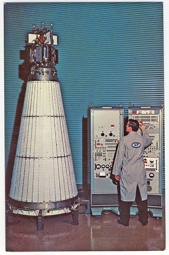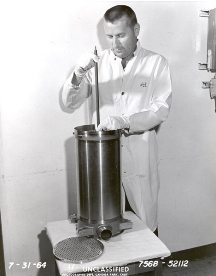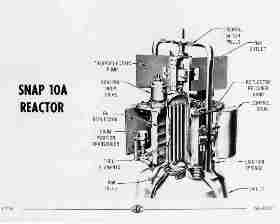SNAP Overview
The objective of the government-sponsored System for Nuclear Auxiliary Power (SNAP) program was to develop compact, lightweight reliable atomic electric devices for use in space, sea and land use. Atomics International served as the prime contractor to the government for several important facets of the SNAP program.
The United States spent considerable effort in the late 1950’s to 1960’s developing the SNAP system. Many of the facilities constructed within SSFL Area IV in the early 1960’s supported the development and testing of the reactors and the associated hardware. Area IV hosted the testing of the SNAP Experimental Reactor, SNAP 2, SNAP 8 Experimental Reactor, SNAP 8 Developmental Reactor, and the SNAP 10 nuclear reactors. Only the SNAP 10 unit was fitted with a thermoelectric conversion system which produced electricity from the heat generated by the on-board nuclear reactor.
The objective of the SNAP 10A reactor was to produce a minimum of 500 Watts of electricity for a one-year duration or longer. The SNAP system weighed in at less than 950 lb, including instruments and shielding.
The SNAP reactor was designed to be remotely started and operated in space. In this manner, any hazardous radiation associated with the nuclear fission reaction is not produced until after the reactor safely reaches orbit. The hazards to ground personnel are minimized and since radioactive fission products are not present before the reactor is operated, less of a hazard exists during launch if an accidental reentry should occur.
SNAP reactors used enriched uranium fuel with zirconuim hydride as a moderator and liquid sodium potassium alloy as the coolant. The fuel elements were arranged in a geometric lattice called the “core assembly.” A thermoelectric pump was placed above to circulate the coolant throughout the system. Beryllium reflectors placed on ejection springs and held in place by a reflector retainer band were placed around the core. Following successful launch and a radio signal from earth, the reflectors rotated into place and the fission reaction started.
The heat from the reactor was converted directly into electricity by a thermoelectric converter. It was the first complete reactor electrical power system of this type to have progressed through the design, development and flight test stages. The thermoelectric converters are located on the cone-shaped body below the reactor. Heat from the reactor was carried by the liquid metal coolant and piped to heat the underside of the thermoelectric elements. The heat then escaped into space via the cone shaped radiator.
On April 3rd 1965, the SNAP10A was launched from Vandenberg Air Force Base and placed into a 500 nautical mile orbit around Earth. Twelve hours after launch, the nuclear reactor was automatically brought up to operating temperature and initially produced more than 600 watts of electrical power. Following 43 days of successful operation, the reactor was shut down as the result of a high voltage failure in the electrical system of the Agena spacecraft. All flight test objectives were met with the exception of the expected length of operation. The reactor remains in polar orbit today.
System for Nuclear Auxiliary Power test operations were held primarily within six buildings at the SSFL between 1956 and 1971. These buildings included 4010, 4012, 4019, 4024, 4059 and 4373. Click here for a short history these buildings.



